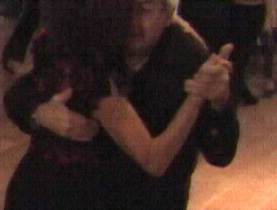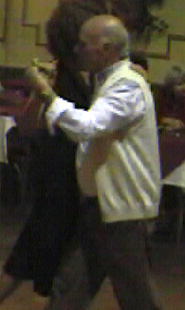The Man's Left Hand
How the man holds his left hand and arm may appear rather simple… but it’s not. And it seems to be one of the things I have a lot of trouble with. There are three basic decisions that a man needs to make about where and how to grasp his partner's right hand: how high to hold the hand, how far from the body to hold the hand, and how to position wrist. Let’s look at a range of possibilities displayed by some of the best milongueros, and see what we can learn from them.
The first thing we'll look at is hand height. The choices are high, medium and low:


Both Ricardo Vidort and Luis Grandona held their left hands high.
Ricardo Vidort's hand is about level with his forehead, and Luis' is even a little higher. Because I spent time with Ricardo when I was first in Buenos Aires, I picked up his habit of holding my hand high. But Ricardo was a short milonguero, and holding his hand higher was comfortable for the women he danced with. Luis is also short—you can see from the pictures that Alej is actually taller than both of them, so it's a comfortable height for her. But for someone 6 ft. tall, to hold the left hand high can be uncomfortable for his partner, and if you're already one of the taller dancers on the floor, it may look a ittle odd to dance around with your hand held up even higher in the air.
Another choice to be made is how far from the body to hold your hand. El Gallego, who has a very elegant style, holds his hand quite far from his body, with his palm slightly up:

El Gallego holds his left hand far out to the side. (Interesting note: Look at how much of the front row of tables seems
to have already emptied onto the floor, while the milongueros in the back rows are still looking for partners!)
In the picture above, you can see that El Gallego uses a medium to low position for his hand, but he holds Alej's hand very far out to the side. I've experimented with this, and, surprisingly, I find that when I do it, I seem to begin pick up other elements of his dancing style as well. Other dancers hold the hand in much closer. To me, it doesn't seem quite as stylish, but many women find it very comfortable, and I spent some time using it, with a bit of a palm up position. It's a position used by some of the best milongueros:


El Malevo (left) keeps his hand in so close to his shoulder that his forearm
angles in from his elbow, and Carlos (right with Graciela) holds his even closer.

Pocho (above with Alej) also keeps his hand close to his shoulder with the palm slightly up.
Many milongueras find this hand and arm position very comfortable.
The Wrist
The options here are to keep the wrist straight, to curl it in toward the body, or to open it a bit, with the palm facing slightly up (like Pocho in the picture above). Curling the wrist inward seems to be a trend among many of the milongueros. Some of them also curl the wrist downward, with the palm facing the floor. The most prominent of those to use an inward/downward curl was Carlos Gavito, who displayed this style all over the world when he performed:

Gavito's inward and downward wrist curl.
Here are a couple of other milongueros who curl their wrists:



Blas on the left, and Ismael keep their hands at medium height. They also hold their arms
away from the body, with a small amount of inward wrist curl.
The left hand/arm position demonstrated by Blas and Ismael above is a classic milonguero position. The left hand is held at medium height, somewhat wide of the body, with maybe a slight amount of inward wrist curl. And if you're familiar with boxing, you may notice something surprising: the aggressive forward step of the milonguero, combined with the arm position, is almost identical to the position of a prizefighter throwing a left hook!

Here's Osvaldo Buglione with Alej
showing a classic milonguero wrist curl.
I used to use a lot of wrist curl, but just because some milongueros do it, you should be careful about using too much. Look at the position of Marcela Duran's wrist in the picture below dancing with Gavito. It's okay for a performance, and any milonguera will be glad to put up with it for a tanda or two with an excellent dancer, but it can be uncomfortable for a woman to spend the whole night dancing with her wrist bent back.
And this arm position can cause problems for the man as well. Try this experiment: stand in front of a mirror and hold your left arm out to the side in about the position El Gallego uses in the third picture. Now tighten all the muscles in your arm. Next, raise your arm and curl your wrist in so your hand is closer to your left ear, and tighten the same muscles. Can you see the difference? When your arm is out to the side and you tighten it, the muscles in your left shoulder and neck should remain relatively unaffected. But when you tighten the muscles with your fist up near your ear, your bicep tightens, your shoulder muscles also begin to tighten, and the muscles on the left side of your neck tighten a little as well. If you look closely, you should see the result: as the muscles contract inside the flexed position of your arm, your left shoulder is pulled up a little, and your head moves slightly to the left. Crowded milongas can sometimes cause a little arm and shoulder tension, so be careful. Using this arm position can pull you off center.

Marcela Duran and Gavito.
Like many things in tango, something that at first seems simple, can quickly become complicated. I began by just sticking my left arm out and dancing, but after awhile I began to spend a lot of time fooling with the position of my left hand. If you hold your hand too high, or too far from the body, it can create tension in the shoulders. Worse, if you’re not careful, a poor left arm position can cause one shoulder to be a slightly higher than the other. Everything is connected, and although it may not seem like much, creating tension or asymmetry in the shoulders can cause real problems in the rest of your dancing. And there are even more important issues involving the left hand.
One mark of bad tango is bouncing or moving the left arm, and another one is pushing or pulling with the left arm while leading. Both of these things can be the result of other technical problems, and they can create technical problems as well. Bouncing or moving the left arm around can be the result of problems in the way a leader steps, and it can also create problems by throwing the rest of the body even further out of balance. A good milonguera will notice it right away.
Leading by slightly pushing or pulling with the left arm can indicate a weak chest lead, and it may also sometimes come from trying to lead complicated moves picked up in workshops. Like many things in tango, it can be both a symptom of sloppy technique, and it can also cause sloppy technique. A leader who is solid in all of the basics of tango; that is one who stays centered and slightly forward when pivoting, walks a straight line, accelerates into each step with the chest forward, lands solidly on a straight leg, and stays in the compás, should not display problems in his left arm. Good technique should result in a natural chest lead without the need to push or pull with the left hand.
In the end, you can’t hide in the milonga. The milongueras will be watching you closely. They’ll see the way you stand, and step, and how well you use the compás. A dancer who moves his left arm is easy to spot, and it sends out a warning signal that’s almost primal. It says, this guy is not good material for a mate. Something is defective. I want to look for a little better dance DNA. And I certainly don’t want to get a sore shoulder from someone who pulls and pushes when he leads.
But I have a solution! Never ever stop working on your basic technique, and then try this: Pretend you are a waiter moving around a crowded room balancing a tray of martinis in your left hand. The glasses are filled right to the brim… and you don’t want to spill them. Keep your arm still and relaxed, let your body move, but don’t spill the drinks! You might be surprised how much it smoothes out your dancing, and I’m pretty sure your partner will like the way it feels.


Finally, here are a couple of pictures of Fino and Maria Teresa.
In the two pictures above, Fino's left hand is held a bit low, a medium distance from the body. His wrist is curled slightly inward, and the palm of his hand is facing very slightly up. This is the position I currently strive for. It's very comfortable for both partners, and, at least to me, it looks good. (Of course, everything in tango affects everything else, and one reason Fino's left hand looks so good is because the position of his head and shoulders is also perfect.)